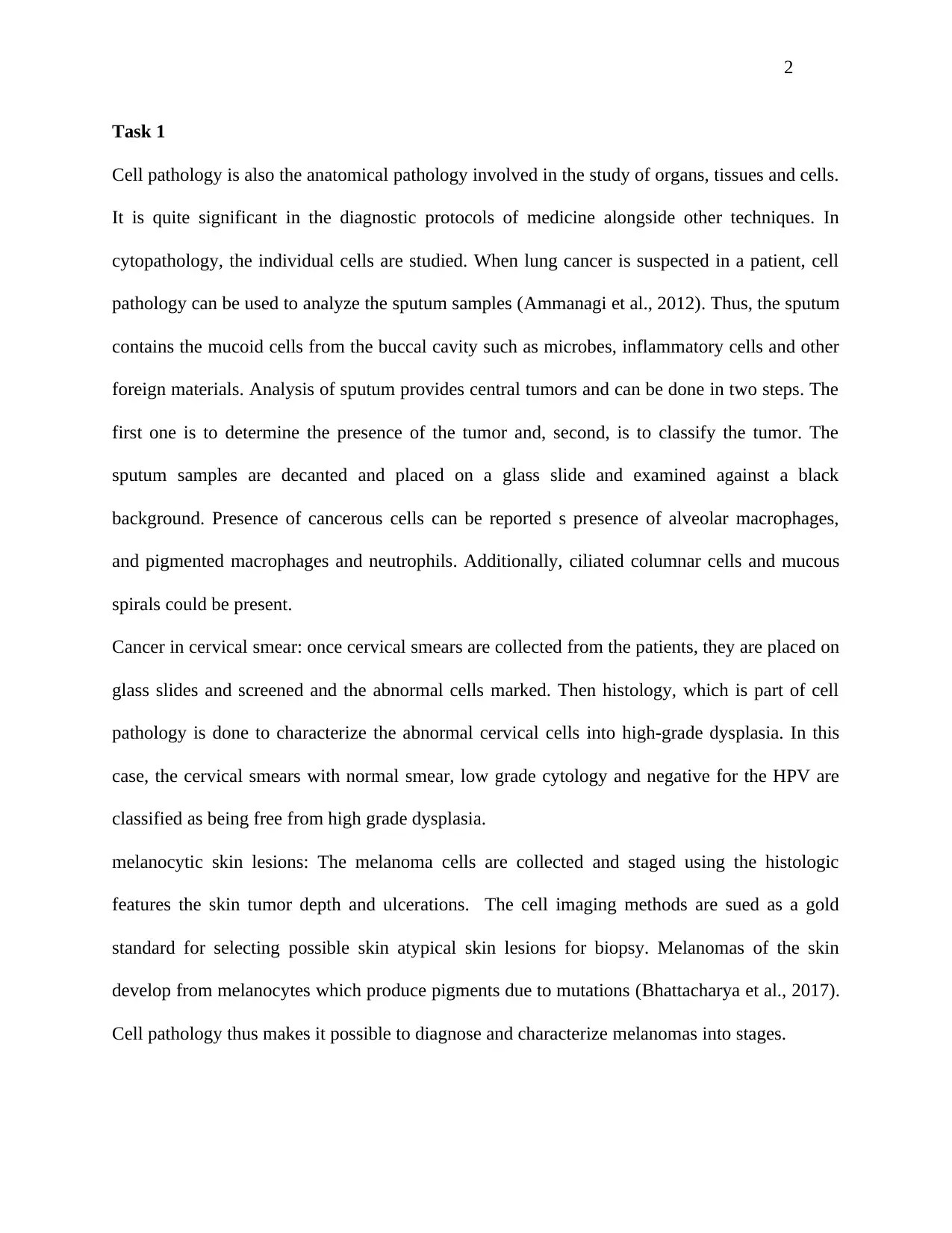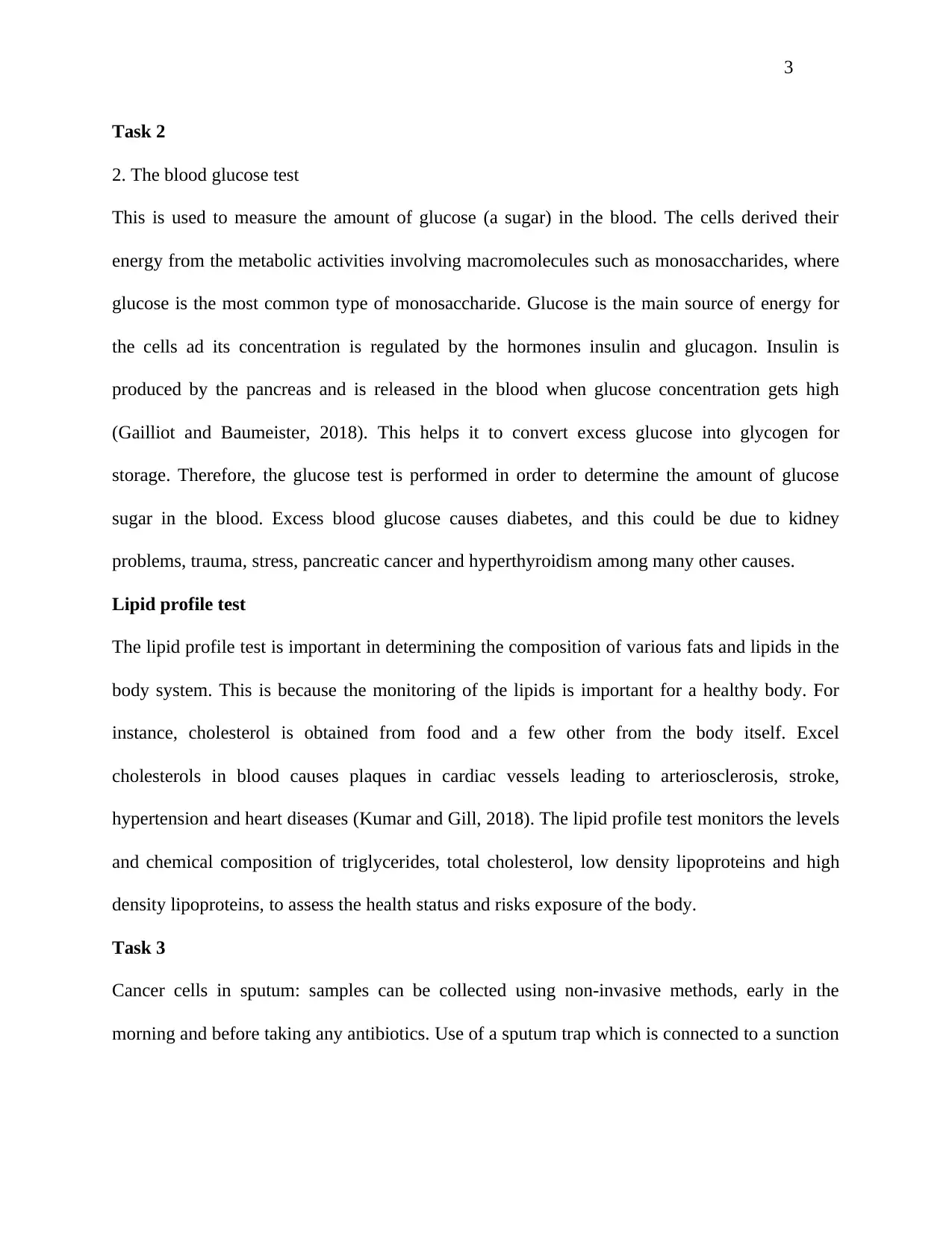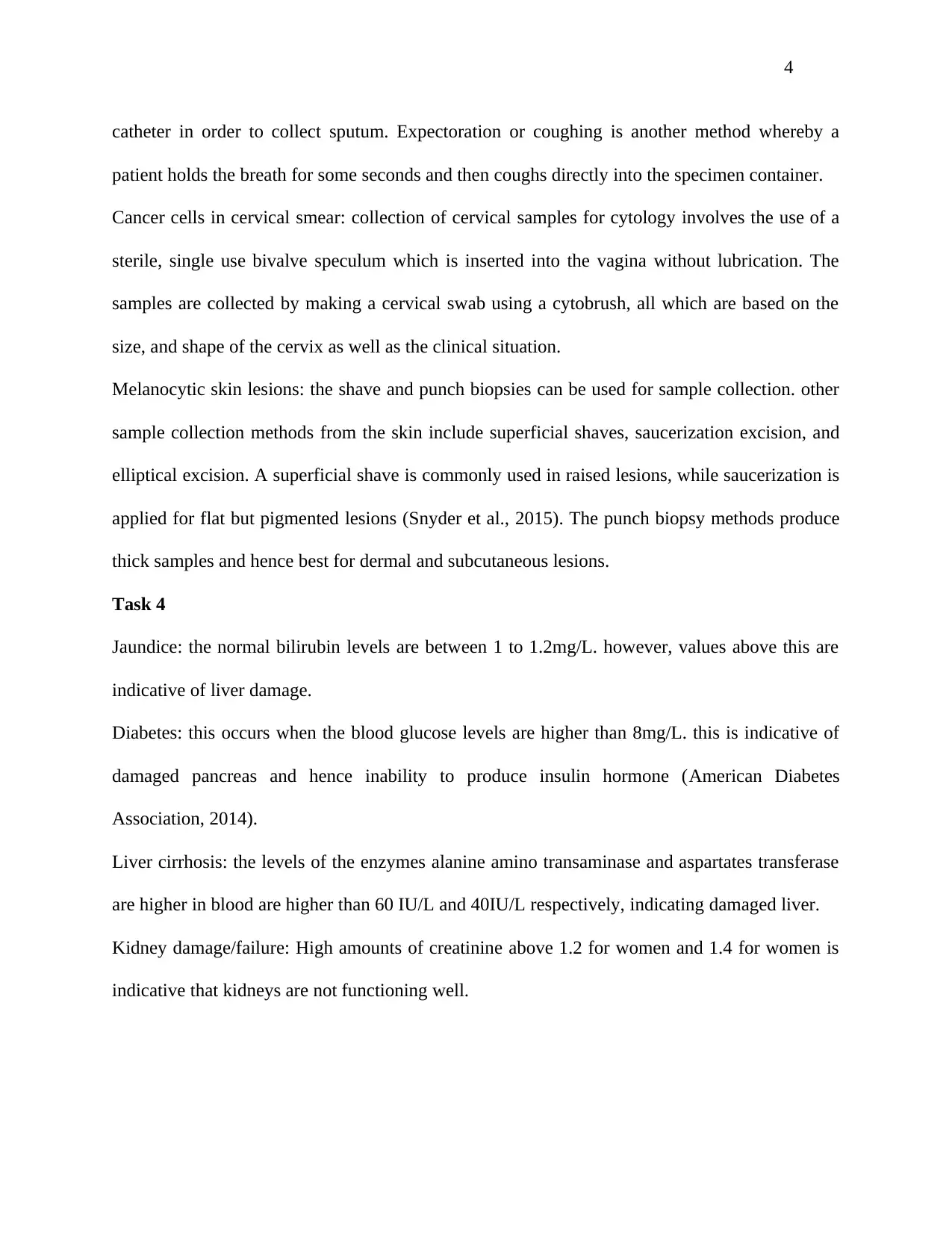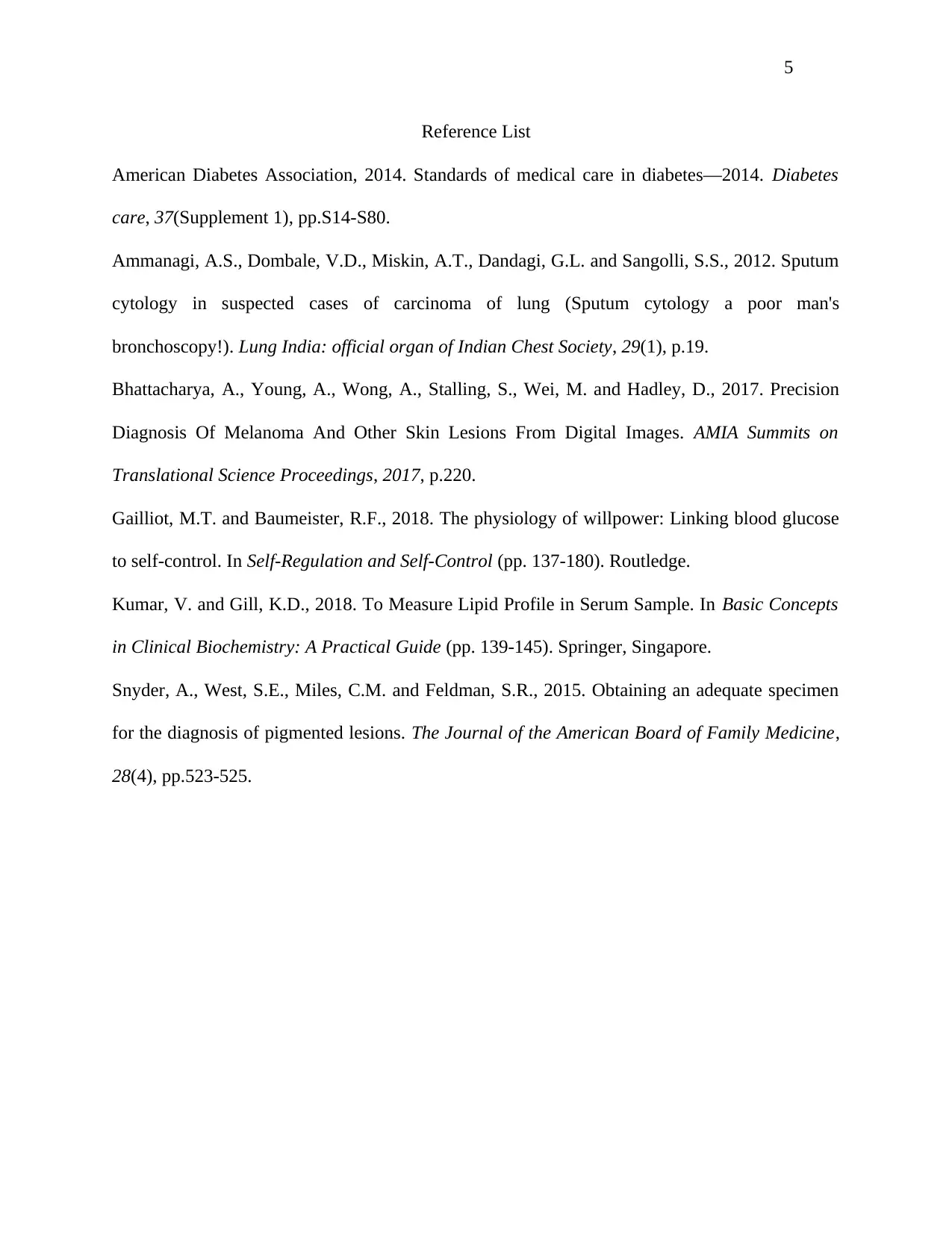Cell Pathology and Diagnostic Methods in Biomedical Science Report
VerifiedAdded on 2021/06/14
|5
|1193
|26
Report
AI Summary
This report delves into the field of cell pathology, exploring its significance in diagnostic protocols within biomedical science. It examines various applications, including sputum analysis for lung cancer detection, cervical smear analysis for cervical cancer screening, and the assessment of melanocytic skin lesions. The report also covers key diagnostic tests such as blood glucose tests and lipid profile tests, explaining their importance and interpretation. Furthermore, it describes the methods used for sample collection in different cases, including sputum collection, cervical sample collection, and skin biopsies. Finally, the report discusses the interpretation of test results, highlighting abnormal values indicative of conditions like jaundice, diabetes, liver cirrhosis, and kidney damage.

1
Biomedical Science
Name
Date of Submission
Biomedical Science
Name
Date of Submission
Paraphrase This Document
Need a fresh take? Get an instant paraphrase of this document with our AI Paraphraser

2
Task 1
Cell pathology is also the anatomical pathology involved in the study of organs, tissues and cells.
It is quite significant in the diagnostic protocols of medicine alongside other techniques. In
cytopathology, the individual cells are studied. When lung cancer is suspected in a patient, cell
pathology can be used to analyze the sputum samples (Ammanagi et al., 2012). Thus, the sputum
contains the mucoid cells from the buccal cavity such as microbes, inflammatory cells and other
foreign materials. Analysis of sputum provides central tumors and can be done in two steps. The
first one is to determine the presence of the tumor and, second, is to classify the tumor. The
sputum samples are decanted and placed on a glass slide and examined against a black
background. Presence of cancerous cells can be reported s presence of alveolar macrophages,
and pigmented macrophages and neutrophils. Additionally, ciliated columnar cells and mucous
spirals could be present.
Cancer in cervical smear: once cervical smears are collected from the patients, they are placed on
glass slides and screened and the abnormal cells marked. Then histology, which is part of cell
pathology is done to characterize the abnormal cervical cells into high-grade dysplasia. In this
case, the cervical smears with normal smear, low grade cytology and negative for the HPV are
classified as being free from high grade dysplasia.
melanocytic skin lesions: The melanoma cells are collected and staged using the histologic
features the skin tumor depth and ulcerations. The cell imaging methods are sued as a gold
standard for selecting possible skin atypical skin lesions for biopsy. Melanomas of the skin
develop from melanocytes which produce pigments due to mutations (Bhattacharya et al., 2017).
Cell pathology thus makes it possible to diagnose and characterize melanomas into stages.
Task 1
Cell pathology is also the anatomical pathology involved in the study of organs, tissues and cells.
It is quite significant in the diagnostic protocols of medicine alongside other techniques. In
cytopathology, the individual cells are studied. When lung cancer is suspected in a patient, cell
pathology can be used to analyze the sputum samples (Ammanagi et al., 2012). Thus, the sputum
contains the mucoid cells from the buccal cavity such as microbes, inflammatory cells and other
foreign materials. Analysis of sputum provides central tumors and can be done in two steps. The
first one is to determine the presence of the tumor and, second, is to classify the tumor. The
sputum samples are decanted and placed on a glass slide and examined against a black
background. Presence of cancerous cells can be reported s presence of alveolar macrophages,
and pigmented macrophages and neutrophils. Additionally, ciliated columnar cells and mucous
spirals could be present.
Cancer in cervical smear: once cervical smears are collected from the patients, they are placed on
glass slides and screened and the abnormal cells marked. Then histology, which is part of cell
pathology is done to characterize the abnormal cervical cells into high-grade dysplasia. In this
case, the cervical smears with normal smear, low grade cytology and negative for the HPV are
classified as being free from high grade dysplasia.
melanocytic skin lesions: The melanoma cells are collected and staged using the histologic
features the skin tumor depth and ulcerations. The cell imaging methods are sued as a gold
standard for selecting possible skin atypical skin lesions for biopsy. Melanomas of the skin
develop from melanocytes which produce pigments due to mutations (Bhattacharya et al., 2017).
Cell pathology thus makes it possible to diagnose and characterize melanomas into stages.

3
Task 2
2. The blood glucose test
This is used to measure the amount of glucose (a sugar) in the blood. The cells derived their
energy from the metabolic activities involving macromolecules such as monosaccharides, where
glucose is the most common type of monosaccharide. Glucose is the main source of energy for
the cells ad its concentration is regulated by the hormones insulin and glucagon. Insulin is
produced by the pancreas and is released in the blood when glucose concentration gets high
(Gailliot and Baumeister, 2018). This helps it to convert excess glucose into glycogen for
storage. Therefore, the glucose test is performed in order to determine the amount of glucose
sugar in the blood. Excess blood glucose causes diabetes, and this could be due to kidney
problems, trauma, stress, pancreatic cancer and hyperthyroidism among many other causes.
Lipid profile test
The lipid profile test is important in determining the composition of various fats and lipids in the
body system. This is because the monitoring of the lipids is important for a healthy body. For
instance, cholesterol is obtained from food and a few other from the body itself. Excel
cholesterols in blood causes plaques in cardiac vessels leading to arteriosclerosis, stroke,
hypertension and heart diseases (Kumar and Gill, 2018). The lipid profile test monitors the levels
and chemical composition of triglycerides, total cholesterol, low density lipoproteins and high
density lipoproteins, to assess the health status and risks exposure of the body.
Task 3
Cancer cells in sputum: samples can be collected using non-invasive methods, early in the
morning and before taking any antibiotics. Use of a sputum trap which is connected to a sunction
Task 2
2. The blood glucose test
This is used to measure the amount of glucose (a sugar) in the blood. The cells derived their
energy from the metabolic activities involving macromolecules such as monosaccharides, where
glucose is the most common type of monosaccharide. Glucose is the main source of energy for
the cells ad its concentration is regulated by the hormones insulin and glucagon. Insulin is
produced by the pancreas and is released in the blood when glucose concentration gets high
(Gailliot and Baumeister, 2018). This helps it to convert excess glucose into glycogen for
storage. Therefore, the glucose test is performed in order to determine the amount of glucose
sugar in the blood. Excess blood glucose causes diabetes, and this could be due to kidney
problems, trauma, stress, pancreatic cancer and hyperthyroidism among many other causes.
Lipid profile test
The lipid profile test is important in determining the composition of various fats and lipids in the
body system. This is because the monitoring of the lipids is important for a healthy body. For
instance, cholesterol is obtained from food and a few other from the body itself. Excel
cholesterols in blood causes plaques in cardiac vessels leading to arteriosclerosis, stroke,
hypertension and heart diseases (Kumar and Gill, 2018). The lipid profile test monitors the levels
and chemical composition of triglycerides, total cholesterol, low density lipoproteins and high
density lipoproteins, to assess the health status and risks exposure of the body.
Task 3
Cancer cells in sputum: samples can be collected using non-invasive methods, early in the
morning and before taking any antibiotics. Use of a sputum trap which is connected to a sunction
⊘ This is a preview!⊘
Do you want full access?
Subscribe today to unlock all pages.

Trusted by 1+ million students worldwide

4
catheter in order to collect sputum. Expectoration or coughing is another method whereby a
patient holds the breath for some seconds and then coughs directly into the specimen container.
Cancer cells in cervical smear: collection of cervical samples for cytology involves the use of a
sterile, single use bivalve speculum which is inserted into the vagina without lubrication. The
samples are collected by making a cervical swab using a cytobrush, all which are based on the
size, and shape of the cervix as well as the clinical situation.
Melanocytic skin lesions: the shave and punch biopsies can be used for sample collection. other
sample collection methods from the skin include superficial shaves, saucerization excision, and
elliptical excision. A superficial shave is commonly used in raised lesions, while saucerization is
applied for flat but pigmented lesions (Snyder et al., 2015). The punch biopsy methods produce
thick samples and hence best for dermal and subcutaneous lesions.
Task 4
Jaundice: the normal bilirubin levels are between 1 to 1.2mg/L. however, values above this are
indicative of liver damage.
Diabetes: this occurs when the blood glucose levels are higher than 8mg/L. this is indicative of
damaged pancreas and hence inability to produce insulin hormone (American Diabetes
Association, 2014).
Liver cirrhosis: the levels of the enzymes alanine amino transaminase and aspartates transferase
are higher in blood are higher than 60 IU/L and 40IU/L respectively, indicating damaged liver.
Kidney damage/failure: High amounts of creatinine above 1.2 for women and 1.4 for women is
indicative that kidneys are not functioning well.
catheter in order to collect sputum. Expectoration or coughing is another method whereby a
patient holds the breath for some seconds and then coughs directly into the specimen container.
Cancer cells in cervical smear: collection of cervical samples for cytology involves the use of a
sterile, single use bivalve speculum which is inserted into the vagina without lubrication. The
samples are collected by making a cervical swab using a cytobrush, all which are based on the
size, and shape of the cervix as well as the clinical situation.
Melanocytic skin lesions: the shave and punch biopsies can be used for sample collection. other
sample collection methods from the skin include superficial shaves, saucerization excision, and
elliptical excision. A superficial shave is commonly used in raised lesions, while saucerization is
applied for flat but pigmented lesions (Snyder et al., 2015). The punch biopsy methods produce
thick samples and hence best for dermal and subcutaneous lesions.
Task 4
Jaundice: the normal bilirubin levels are between 1 to 1.2mg/L. however, values above this are
indicative of liver damage.
Diabetes: this occurs when the blood glucose levels are higher than 8mg/L. this is indicative of
damaged pancreas and hence inability to produce insulin hormone (American Diabetes
Association, 2014).
Liver cirrhosis: the levels of the enzymes alanine amino transaminase and aspartates transferase
are higher in blood are higher than 60 IU/L and 40IU/L respectively, indicating damaged liver.
Kidney damage/failure: High amounts of creatinine above 1.2 for women and 1.4 for women is
indicative that kidneys are not functioning well.
Paraphrase This Document
Need a fresh take? Get an instant paraphrase of this document with our AI Paraphraser

5
Reference List
American Diabetes Association, 2014. Standards of medical care in diabetes—2014. Diabetes
care, 37(Supplement 1), pp.S14-S80.
Ammanagi, A.S., Dombale, V.D., Miskin, A.T., Dandagi, G.L. and Sangolli, S.S., 2012. Sputum
cytology in suspected cases of carcinoma of lung (Sputum cytology a poor man's
bronchoscopy!). Lung India: official organ of Indian Chest Society, 29(1), p.19.
Bhattacharya, A., Young, A., Wong, A., Stalling, S., Wei, M. and Hadley, D., 2017. Precision
Diagnosis Of Melanoma And Other Skin Lesions From Digital Images. AMIA Summits on
Translational Science Proceedings, 2017, p.220.
Gailliot, M.T. and Baumeister, R.F., 2018. The physiology of willpower: Linking blood glucose
to self-control. In Self-Regulation and Self-Control (pp. 137-180). Routledge.
Kumar, V. and Gill, K.D., 2018. To Measure Lipid Profile in Serum Sample. In Basic Concepts
in Clinical Biochemistry: A Practical Guide (pp. 139-145). Springer, Singapore.
Snyder, A., West, S.E., Miles, C.M. and Feldman, S.R., 2015. Obtaining an adequate specimen
for the diagnosis of pigmented lesions. The Journal of the American Board of Family Medicine,
28(4), pp.523-525.
Reference List
American Diabetes Association, 2014. Standards of medical care in diabetes—2014. Diabetes
care, 37(Supplement 1), pp.S14-S80.
Ammanagi, A.S., Dombale, V.D., Miskin, A.T., Dandagi, G.L. and Sangolli, S.S., 2012. Sputum
cytology in suspected cases of carcinoma of lung (Sputum cytology a poor man's
bronchoscopy!). Lung India: official organ of Indian Chest Society, 29(1), p.19.
Bhattacharya, A., Young, A., Wong, A., Stalling, S., Wei, M. and Hadley, D., 2017. Precision
Diagnosis Of Melanoma And Other Skin Lesions From Digital Images. AMIA Summits on
Translational Science Proceedings, 2017, p.220.
Gailliot, M.T. and Baumeister, R.F., 2018. The physiology of willpower: Linking blood glucose
to self-control. In Self-Regulation and Self-Control (pp. 137-180). Routledge.
Kumar, V. and Gill, K.D., 2018. To Measure Lipid Profile in Serum Sample. In Basic Concepts
in Clinical Biochemistry: A Practical Guide (pp. 139-145). Springer, Singapore.
Snyder, A., West, S.E., Miles, C.M. and Feldman, S.R., 2015. Obtaining an adequate specimen
for the diagnosis of pigmented lesions. The Journal of the American Board of Family Medicine,
28(4), pp.523-525.
1 out of 5
Your All-in-One AI-Powered Toolkit for Academic Success.
+13062052269
info@desklib.com
Available 24*7 on WhatsApp / Email
![[object Object]](/_next/static/media/star-bottom.7253800d.svg)
Unlock your academic potential
Copyright © 2020–2025 A2Z Services. All Rights Reserved. Developed and managed by ZUCOL.